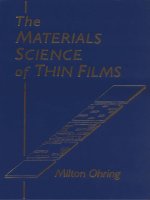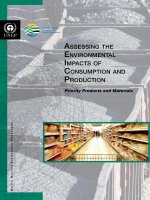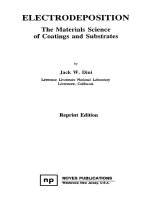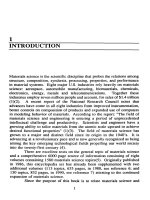electrodeposition - the materials science of coatings and substrates 1993 - dini
Bạn đang xem bản rút gọn của tài liệu. Xem và tải ngay bản đầy đủ của tài liệu tại đây (5.62 MB, 378 trang )
ELECTRODEPOSITION
The Materials Science
of
Coatings and Substrates
Jack
W.
Dini
Lawrence
Livcrmorc
National
Laboratory
Livemiore.
Califorilia
Reprint Edition
NOYES
PUBLICATIONS
Westwood,
New
Jersey,
U.S.A.
Copyright
0
1993 by Jack
W.
Dini
No
part
of
this book may be reproduced or utilized in
any form or by any means, electronic or mechanical,
including photocopying, recording or by any informa-
tion storage and retrieval system, without permission
in writing from the Publisher.
Library of Congress Catalog Card Number: 92-27804
Printed in the United States
Published in the United States
of
America
by
Noyes Publications
Fairview Avenue, Westwood, New Jersey
07675
ISBN: 0-8155-1320-8
IO
9
a
7
65
4
Library
of
Congress Cataloging-in-Publication Data
Dini,
J.W.
Electrodeposition
:
the materials science
of
coatings and
substrates /by Jack
W.
Dini.
p.
cm.
Includes bibliographical references and index.
1.
Electroplating.
I.
Title.
ISBN
0-8155-1320-8
TS670.D55 1992
671.7’32 dc20
92-27804
CIP
MATERIALS SCIENCE AND PROCESS TECHNOLOGY SERIES
Editors
Rointan
F.
Bunshah, University of California,
Los
Angeles
(Series Editor)
Gary E. McGuire, Microelectronics Center of North Carolina
(Series Editor)
Stephen M. Rossnagel, IBM Thomas
J.
Watson Research Center
(Consulting Editor)
Electronic Materials and Process Technology
DEPOSITION TECHNOLOGIES FOR FILMS AND COATINGS: by Rointan F. Bunshah et
CHEMICAL VAPOR DEPOSITION FOR MICROELECTRONICS: by Arthur Sherman
SEMICONDUCTOR MATERIALS AND PROCESS TECHNOLOGY HANDBOOK: edited by
HYBRID MICROCIRCUIT'TECHNOLOGY HANDBOOK: by James
J.
Licari and Leonard
R.
HANDBOOK
OF
THIN FILM DEPOSITION PROCESSES AND TECHNIQUES: edited by
IONIZED-CLUSTER BEAM DEPOSITION AND EPITAXY: by Toshinori Takagi
DIFFUSION PHENOMENA IN THIN FILMS AND MICROELECTRONIC MATERIALS: edited
HANDBOOK OF CONTAMINATION CONTROL IN MICROELECTRONICS: edited by Donald
HANDBOOK OF ION BEAM PROCESSING TECHNOLOGY: edited by Jerome
J.
Cuomo,
CHARACTERIZATION OF SEMICONDUCTOR MATERIALS-Volume
1
:
edited by Gary E.
HANDBOOK
OF
PLASMA PROCESSING TECHNOLOGY: edited by Stephen
M.
Rossnagel,
HANDBOOK
OF
SEMICONDUCTOR SILICON TECHNOLOGY: edited by William C. OMara,
HANDBOOK
OF
POLYMER COATINGS FOR ELECTRONICS-Second Edition: by James
HANDBOOK
OF
SPUTTER DEPOSITION TECHNOLOGY: by Kiyotaka Wasa and Shigeru
HANDBOOK OF
VLSl
MICROLITHOGRAPHY: edited by William B. Glendinning and John
CHEMISTRY
OF
SUPERCONDUCTOR MATERIALS: edited by Terrell A. Vanderah
CHEMICAL VAPOR DEPOSITION
OF
TUNGSTEN AND TUNGSTEN SILICIDES: by John
ELECTROCHEMISTRY OF SEMICONDUCTORS AND ELECTRONICS: edited by John
(continued)
al
Gary E. McGuire
Enlow
Klaus K. Schuegraf
by Devendra Gupta and Paul
S.
Ho
L. Tolliver
Stephen
M.
Rossnagel, and Harold
R.
Kaufman
M
c
G u
i
r
e
Jerome
J.
Cuomo, and William D. Westwood
Robert B. Herring, and Lee P. Hunt
J.
Licari and Laura A. Hughes
Hayakawa
N. Helbert
E.J. Schmitz
McHardy and Frank Ludwig
V
vi
Series
HANDBOOK OF CHEMICAL VAPOR DEPOSITION: by Hugh
0.
Pierson
DIAMOND FILMS AND COATINGS: edited by Robert F. Davis
ELECTRODEPOSITION: by Jack W. Dini
Ceramic and Other Materials-Processing and Technology
SOL-GEL TECHNOLOGY FOR THIN FILMS, FIBERS, PREFORMS, ELECTRONICS AND
SPECIALTY SHAPES: edited by Lisa C. Klein
FIBER REINFORCED CERAMIC COMPOSITES: by K.S. Mazdiyasni
ADVANCED CERAMIC PROCESSING AND TECHNOLOGY-Volume
1:
edited by Jon G.P.
FRICTION AND WEAR TRANSITIONS OF MATERIALS: by Peter
J.
Blau
SHOCK WAVES FOR INDUSTRIAL APPLICATIONS: edited by Lawrence E. Murr
SPECIAL MELTING AND PROCESSING TECHNOLOGIES: edited by G.K. Bhat
CORROSION OF GLASS, CERAMICS AND CERAMIC SUPERCONDUCTORS: edited by
HANDBOOK OF INDUSTRIAL REFRACTORIES TECHNOLOGY: by Stephen
C.
Carniglia
CERAMIC FILMS AND COATINGS: edited by John B. Wachtman and Richard
A.
Haber
Binner
David
E.
Clark and Bruce
K.
Zoitos
and Gordon
L.
Barna
Related
Tides
ADHESIVES TECHNOLOGY HANDBOOK: by Arthur H. Landrock
HANDBOOK
OF
THERMOSET PLASTICS: edited by Sidney H. Goodman
SURFACE PREPARATION TECHNIQUES FOR ADHESIVE BONDING: by Raymond F.
FORMULATING PLASTICS AND ELASTOMERS BY COMPUTER: by Ralph D. Hermansen
HANDBOOK OF ADHESIVE BONDED STRUCTURAL REPAIR: by Raymond F. Wegman
CARBON-CARBON MATERIALS AND COMPOSITES: edited by John D. Buckley and Dan
Wegrnan
and Thomas
R.
Tullos
D. Edie
PREFACE
INTRODUCTION
This book grew
out
of a short course that
I've
taught with Mort Schwartz
and then Dick Baker. When Rudy Johnson (my colleague for many years
at Sandia) saw my notes he suggested that, they should
be
put in the form
of
a book. His suggestion was the prod that
I
needed
to
undertake this
project.
Knowledge of the relationships between microstructure and
mechanical properties has always been one of the primary goals of
metallurgy and materials science. This has led to the point that "tailored"
properties
of
materials are now a reality. We are
no
longer limited to
combinations of elements allowed by nature
to
form structures dictated by
the small differences in the forces between atoms and the free energies in
condensed matter that define equilibrium form.
The fascinating field
of
electrodeposition allows one
to
"tailor" the
surface properties of a bulk material or in the case
of
electroforming, the
entire part. Deposits can be produced to meet a variety of demands
of
the
designer. For this reason and for the possibilities that exist in terms
of
"new materials" for a variety
of
applications, a thorough understanding
of
materials science and principles is of utmost importance. This
book
is
intended to provide some of that understanding.
The sequence of chapters in the book takes the reader from the
substrate to the outer surface
of
the coating.
It
starts with the substrate
(Hydrogen Embrittlement), then proceeds
to
the substrate/coating interface
(Adhesion, Diffusion), then the bulk of the coating (Structure, Properties,
Addition Agents, Stress, Porosity) and finally to the environmental interface
of
the coating (Corrosion, Wear).
Although the title
ELECTRODEPOSITION:
The
Materials Science
of
Coatings and Substrates
sounds specific to electrodeposition,
this
does
not
mean that other coating processes are not covered. Coating technologies
such as physical vapor deposition, chemical vapor deposition, plasma
spraying and ion implantation are occasionally discussed. Growth of films
and their performance from a materials science viewpoint have a great deal
of commonality regardless of the technique used
to
deposit the film.
I
am
indebted to many individuals who have -provided help along
the way. Ted Pavlish opened my eyes to the fascinatingfield
of
electroplal-
vii
viii Preface
ing in
1950
and he and his brother Arnold nurtured me for
9
years at
Cleveland Supply Company (now Pavco)
during
my high school and college
years. Following this, a few years at Battelle Columbus Laboratories gave
me the chance to work with people like Glenn Schaer, Bill Safranek,
John
Beach, Charlie Faust, and Hugh Miller, some
of
the forerunners in
electroplating research and development at that time. At Sandia Livermore,
Rudy Johnson and
I
were a team for over
15
years and even though we’ve
been apart for the past
13
years, some people still mistake one
of
us
for the
other.
It
was always difficult to determine where Rudy’s effort stopped and
mine began and vice versa. Also at Sandia, there were a number of highly
talented, well educated young materials scientists and engineers who were
quite helpful. Sandia’s practice
of
hiring top-of-theclass people from the
leading schools in the country meant that you learned by just being around
such talent. My thanks
to
all
of
these people and others who were
so
helpful during the years at Sandia. At LLNL, a key individual was Harold
Wiesner who was always available for advice and suggestions. Others at
LLNL who have been particularly helpful include Ron Reno, Fritz
Rittmann, Den Fisher and Tom Beat. Special thanks are due to Mort
Schwartz for his support in introducing me
to
and sharing short course
assignments as well as results of his efforts with graduate students at
UCLA.
I
also thank all of you have helped either through AESF or on
mutual technical projects. Lastly, but not least, thanks
to
George Narita of
Noyes Publications for his help and encouragement in seeing this book to
fruition.
Livermore, California
April,
1992
J.
W.
Dini
NOTICE
To
the
best
of
the
Publisher‘s knowledge
the
information contained
in
this
book
is accurate; however,
the
Publisher assumes
no
responsibility
nor liability
for errors
or
any
consequences
arising
from
the
use
of
the
information contained herein. Final determination
of
the
suitability
of
any
information, procedure,
or
product
for
use
contemplated by
any
user,
and
the
manner
of
that
use,
is
the
sole
responsibility
of
the user.
The
book
is
intended
for
informational
purposes
only. Electrodeposition
raw materials
and
processes
could
be
potentially hazardous and due
caution
should
always
be
exercised
in
the
handling
of
materials
and
equipment. Expert advice should be
obtained
at
all
times
when
implementation is being considered.
CONTENTS
1
.
INTRODUCTION
1
Comments on Electrodeposition
2
Factors Affecting Coatings
2
References
9
2
.
HYDROGEN EMBRITTLEMENT
11
Mechanism
20
Steels
20
Prevention of Hydrogen Embrittlement
22
Cd-Ti Plating
26
Mechanical Plating
27
Physical Vapor Deposition
29
Permeation
29
Electroless Copper
33
Chemical Milling
36
Tests for Hydrogen Embrittlement
36
References
40
3
.
ADHESION
46
Introduction
46
Testing
48
A
.
Conical Head Tensile Test
48
B .
Ring Shear Test
50
C
.
Flyer Plate Tests
51
D
.
Peel Test
53
Comparing Adhesion Test Results
54
Techniques for Obtaining Good Adhesion
55
A
.
Pickling in Concentrated Acids
56
B
.
Mechanical Roughening
58
ix
x
Contents
C
.
Intermediate Strike Coatings
59
D
.
Displacement Films
65
E
.
Anodic Oxidation
69
F
.
Heating After Plating
69
G
.
Plasma/Gas Etching
72
H
.
Physical Vapor Deposition (Ion Plating)
73
I
.
Other Adhesion Enhancement Techniques
77
References
84
4
.
DIFFUSION
90
Introduction
90
Good Aspects of Diffusion
91
Using Diffusion to Produce Alloy Coatings'
91
Diffusion Mechanisms
91
Kirkendall Voids
95
Diffusion Rate
98
Diffusion Barriers
102
A
.
Introduction
102
B
.
Electronics Applications
103
C
.
Diffusion
of
Oxygen Through Silver
104
D
.
Nickel as
a
Diffusion Barrier for Brazing
105
Diffusion Welding
or
Bonding
105
References
110
5
.
PROPERTIES
114
Introduction
114
Tensile Properties
115
Strength and Ductility of Thin Deposits
119
Hall-Petch Relationship
122
Superplasticity
124
Influence of Impurities
126
High Temperature Embrittlement of Nickel and
Copper
129
Oxygen in Chromium Deposits
132
Physically Vapor Deposited Films
132
References
135
6
.
STRUCTURE
141
Introduction
141
Structure of Electrodeposited and Electroless
Coatings
141
Influence of Substrate
150
Phase Transformations
150
A
.
Electroless Nickel
154
Structure of Physically Vapor Deposited Coatings
148
Contents
xi
7
.
B
.
Gold-Copper
155
C
.
Transformation in Tin-Nickel
155
D
.
Palladium
156
E
.
Cobalt
156
F
.
Miscellaneous
157
Microstructural Instability at Room Temperature
157
Texture
162
Influence of Texture on Properties
166
C
.
Etching Characteristics of Copper Foil
170
D
.
Paint Adhesion on Zinc Coated Steel
171
E
.
Contact Resistance
of
Electroplated Nickel
171
F
.
Magnetic Properties
of
Cobalt/Phosphorus Films
173
G
.
Wear Resistance
174
I
.
Electrodeposited Copper Recrystallization
175
A.Copper
157
B
.
Silver
161
A
.
Formability
166
B
.
Corrosion
166
H
.
Porosity
174
Fractals
175
A
.
Introduction
175
B .
Fractal Dimension
178
C
.
Fractals and Electrodeposition
179
D
.
Surface Roughness
181
References
186
ADDITIVES
195
196
Introduction
195
Some History and Folklore
Influence
on
Properties
200
Influence on Leveling
203
Influence on Brightening
206
Classification and Types
of
Additives
207
Mechanisms
213
Decomposition of Addition Agents
215
Control and Analysis
of
Additives
217
Hull
Cell
217
Bent Cathode
220
Chromatography
221
Electroanalytical Techniques
227
A
.
Polarography
227
B .
Cyclic Voltammetry Stripping
232
C
.
Impedance Techniques
D
.
Spectrophotometry
236
236
References
237
xii
Contents
8
.
POROSITY 249
Introduction
249
Influence on Properties
250
Good Aspects About Porosity
Classification of Pores
252
Causes of Porosity
253
Factors Relating to the Substrate
257
Parameters
261
Methods to Reduce Porosity
261
A
.
Underplates
261
B
.
Crystallographic Orientation
262
and Physically Vapor Deposited Films
D
.
Hot Isostatic Pressing (HIP)
267
Porosity Testing
267
A .
Chemical Tests
268
B
.
Gas Exposure Tests
268
C
.
Electrolytic Techniques
269
D
.
Microscopic Techniques
273
References
274
252
Influence of Plating Solution and Its Operating
C
.
Deposition Technique-Comparison
of
Electroplated
265
9
.
nRESS
279
Introduction
279
Thermal. Residual. and Stress During Service
281
Influence of Residual Stress on Fatigue
282
How
to Minimize Stress in Deposits
284
Influence
of
Substrate
284
Influence
of
Plating Solution
287
Influence
of
Additives
287
Influence
of
Plating Solution Temperature
289
Stress Measurement
289
Rigid or Flexible Strip
290
Spiral Contractometer
291
Stresometer
293
Strain Gage
294
Dilatometer
294
Hole Drilling
296
Holographic Interferometry
297
Stress Theories
297
Crystallite Joining
298
Hydrogen
298
Changes in Foreign Substrates
299
Excess Energy
299
X-Ray
293
Contents
xiii
Lattice Defects
299
References 301
10 .
CORROSION
304
Introduction
304
Substrates
306
Coatings
308
A .
Structure
310
B
.
Grain Size 312
C
.
Porosity
313
D
.
Codeposited Metallic Impurities
313
E
.
Metallic Underplates
313
.
Process Residues
313
Decorative Nickel-Chromium Coatings
314
Corrosion Tests
317
References
319
F
11
.
WEAR
321
Introduction
321
Classification
of
Wear
322
Wear Test Methods
324
Taber Abrader
324
Falex Lubricant Tester
325
Reciprocating Scratch Test
325
Pin-on-Flat
326
Alfa Wear Test
327
Accelerated Yarnline Wear Test
328
Chromium
328
Chromium
Plus
Ion Implantation
Electroless Nickel
332
Electroless Nickel with Dispersed Particles
Electroless Nickel Plus Chromium
340
Precious Metals
341
A.Gold
341
B
.
Palladium
342
C
.
Rhodium
343
D
.
Silver
344
Other Electrodeposited Coatings
344
Anodized Aluminum Coatings
345
A
.
Introduction
345
B
.
Surface Finish
346
C
.
Sealing
347
Coatings for High Temperature Applications
349
Composition Modulated Coatings
350
References
351
332
336
INDEX
355
1
INTRODUCTION
Materials science is the scientific discipline that probes the relations among
structure, composition, synthesis, processing, properties, and performance
in material systems. Eight major
U.S.
industries rely heavily on materials
science: aerospace, automobile manufacturing, biomaterials, chemicals,
electronics, energy, metals and telecommunications. Together these
industries employ seven million people and account,
for
sales of
$1.4
trillion
(1)(2).
A
recent report of the National Research Council notes that
advances have come in all eight industries from improved instrumentation,
better controls on composition of products and expanded use of computers
in modeling behavior
of
materials. According to the report: "The field
of
materials science and engineering is entering a period of unprecedented
intellectual challenge and productivity. Scientists and engineers have a
growing ability
to
tailor materials from the atomic scale upward
to
achieve
desired functional properties"
(1)(3).
The field of materials science has
grown
to
a major and distinct field since its origin in the
1940's.
It
is
advancing at a revolutionary pace and is now generally recognized as being
among the key emerging technological fields propelling our world society
into the twenty-first century
(4).
There are excellent texts on the general topic of materials science
and a comprehensive
6000
page source of information consisting of eight
volumes containing
1580
materials science topics(5). Originally published
in
1986,
this encyclopedia set has already been supplemented with two
additional yolumes
(113
topics,
653
pages, in
1988,
see reference
6;
and
130
topics,
832
pages, in
1990,
see reference
7)
attesting
to
the continued
expansion of materials science.
Since the purpose of this
book
is
to
relate materials science and
1
2
Electrodeposition
electrodeposition some brief history is in order. The 1949 text by Blum and
Hogaboom
(8)
presents some of the principles of materials science even
though it was not
so
named at that time.
The book contains a number of
photographs of structures of electrodeposits and data on properties. In the
1960's Read extended
this
coverage by showing the remarkable range of
structures and properties that can
be
achieved by electrodepositing a given
metal in a variety
of
ways
(9,lO).
In
more recent times (1982 and 1984)
Weil introduced the topic of materials science of electrodeposits disclosing
how
the
principles
of
materials science can be used to explain various
structures
of
electrodeposits and how these structures influence properties
(11,12).
As
Weil stated: "The understanding that has been gained
is
to
a
great extent responsible for changing plating from
an
art to a science"
(1
1).
Safranek's treatises on properties of deposits (1974 and 1986) are also very
valuable resources (13)(14). These two volumes contain property data from
over
lo00
technical papers.
COMMENTS
ON
ELECTRODEPOSITION
Electrodeposition is an extremely important technology. Covering
inexpensive and widely available base materials with plated layers of
different metals with superior properties extends their use to applications
which otherwise would have been prohibitively expensive (15). However,
it
should be noted that electroplating is not a simple dip and dunk process.
It
is probably one of the
most
complex unit operations known because of
the
unusually large number of critical elementary phenomena
or
process
steps which control the overall process (16).
An
excellent example is the
system model from Rudzki (Figure 1) for metal distribution showing the
interrelation of plating variables and their complexity (17).
Figure 2 is a
simplified version summarizing the factors that influence the properties of
deposits. Electrodeposition involves surface phenomena, solid state
processes, and processes occurring in the liquid state, thereby drawing on
many scientific disciplines as shown in Table 1
(15).
FACTORS AFFECTING COATINGS
It
has been suggested that three different zones: 1) the substrate interface,
2) the coating, and 3) the coating-environment interface have to be
considered when protecting materials with coatings (18). These, plus a
fourth zone- the substrate, are covered in sequential fashion in the following
chapters. Figure 3 shows these zones along with the titles of the chapters.
Introduction
3
Figure
1:
System model illustrating metal distribution relationships.
From
Reference
17.
Reprinted wilh permission
of
ASM International, Metals
Park,
Ohio.
4
Electrodeposition
System components
Tank
Electrodes
Solution composition
Process conditions
Current
Factors influencing
metal distribution Electrodeposit
Geometric
Electrochemical
Incidental
Metal distribution
Composition
Structure
Properties
Figure
2:
Metal distribution relationships
in
electrodeposition.
Table
1:
Interdisciplinary nature
of
Electrodeposition*
Involvement
Electrochemistry Electrode processes
Elecuochemical engineering Transport phenomena
Surface science Analytical tools
Solid state physics
Metallurgy and materials
science
Use
of
quantam mechanical
solid state concepts to study
electrode processes
Properties of deposits
Electronics Modern instrumentation
*
From Reference
15.
Introduction
5
Figure
3:
Important criteria when selecting coatings. This also is a listing
of
the
following chapters in this
book
starting with HYDROGEN EMBRIT-
TLEMENT and proceeding through to WEAR.
6
Electrodeposition
First is the substrate where potential hydrogen embrittlement effects are of
concern. The second zone is the basis metal interface where adhesion
of
the
coating and interdiffusion between the coating and substrate are of
importance. The third zone is the coating itself where composition and
microstructure determine properties and factors such as stress, phase
transformations and grain growth exert noticeable influences.
The final
zone is the environmental interface where the interaction of the coating in
its intended application has to be considered in terms of corrosion and/or
wear.
Clearly, many of the items
are
important in more than one zone.
For example; porosity and/or stress in the substrate (rather than just in the
coating)
can
noticeably influence coating properties; porosity can noticeably
affect corrosion resistance and tensile properties; hydrogen embrittlement is
a factor not only for substrates but also for some coatings; and diffusion
of
codeposited alloying impurities to the surface can noticeably affect wear and
corrosion properties.
For
reasons such
as
these,
many
of
the topics
are
discussed interchangeably throughout the book.
The chapter on HYDROGEN EMBRI'ITLEMENT concentrates
heavily
on
steels since these substrates are particularly susceptible to
damage by hydrogen. This chapter also covers permeation of hydrogen
through various protective coatings, hydrogen embrittlement
of
electroless
copper deposits and hydrogen concerns as a result
of
chemical milling.
The importance of ADHESION is discussed in the next chapter and
this topic is broken down into four categories; interfacial adhesion,
interdiffusion adhesion, intermediate layer adhesion and mechanical
interlocking.
A
variety of quantitative tests for measuring adhesion are
discussed and then a methodology is presented for use when confronted
with difficult-to-plate substrates. Processes that have been used
to
provide
adhesion
of
coatings on difficult-to-plate substrates are discussed and
supported with quantitative data. The relatively new approach
of
combining
physical vapor deposition with electroplating which offers considerable
promise for obtaining adherent bonds between coatings and difficult-to-plate
substrates is also covered. Other techniques such as interface tailoring,
alloying surface layers with metals exhibiting a high negative free energy
of formation, use
of
partial pressure
of
various gases during deposition,
reactive ion mixing and phase-in deposition are also discussed.
DIFFUSION, which is the attempt
of
a system
to
achieve equilibri-
um through elimination
of
concentration gradients, can result in degradation
of
properties and appearance. Diffusion mechanisms are discussed with
particular emphasis placed on Kirkendall voids which can lead
to
loss of
adhesion. Diffusion is influenced by the nature of the atoms, temperature,
concentration gradients, nature of the lattice crystal structure, grain size,
amount
of
impurities and the presence
of
cold work
(19).
An effective way
Introduction
7
to minimize
or
eliminate potential diffusion problems is the use
of
barrier
coatings.
In
some instances, diffusion can benefit coating applications.
Examples include deposition of alloy coatings and diffusion welding which
utilizes diffusion
to
produce high integrity joints in a range
of
both similar
and dissimilar metals.
Although PROPERTIES are discussed throughout the book, this
chapter is included to cover some specifics not covered elsewhere. Topics
include tensile property measurements, strength and ductility of
thin
deposits,
the
Hall-Petch relationship between strength and grain size, and the
influence
of
impurities
on
properties. Superplasticity, which refers
to
the
ability of a material
to
be
stretched to many times its original length, is
covered since electrodeposition offers some potential in this area.
STRUCTURE is one of the longest chapters in the book and
rightfully
so
since structure is
so
dominant a factor
in
materials science.
The variety
of
structures obtainable with electrodeposits are discussed and
illustrated,
as
is the influence of substrate
on
coating structure. Phase
transformations, which can noticeably affect deposit properties, are reviewed
for electroless nickel, gold-copper, tin-nickel, palladium and cobalt deposits.
Microstructural stability
of
copper and silver deposits at room temperature
is
also covered. Texture of deposits is an important structural parameter for
bulk materials and coatings and a good illustration of how properties can
be
tailored for applications such as formability, corrosion resistance, etching
characteristics, contact resistance, magnetics, wear resistance, and porosity.
Fractals, which offer the materials scientist a new way to analyze micro-
structures, provide a new tool for studying surfaces and corrosion processes.
Some concepts
of
fractals are presented as are examples
of
results already
obtained with various surfaces.
ADDITIVES are included as a separate chapter because of their
extreme importance
on
the structure and properties of deposits. Some
of
the
folklore regarding addition agents is discussed and examples included
illustrating the interesting history of this complex aspect of electrodeposi-
tion. Data are presented showing the influence of additives
on
tensile
properties, leveling, and brightening.
Typical additive systems used for
deposition of a variety of deposits are reviewed as are proposed mechanisms
of additive behavior. Control of addition agents via techniques such as the
Hull cell, bent cathode, electroanalytical techniques, chromatography and
other analytical methods is covered in some detail.
POROSITY is one of the main sources of discontinuities in
electrodeposited coatings. It can noticeably inhence corrosion resistance,
mechanical properties, electrical properties and diffusion characteristics.
Items which influence porosity include the substrate, the plating solution
and its operating characteristics, and post plating treatments.
An
effective
way to minimize porosity is to
use
an underplate.
Another
is
to
deposit
8
Electrodeposition
coatings with specific crystallographic orientations which can strongly
influence covering power and rate
of
pore closure. A variety
of
porosity
tests are available for testing coatings and these are discussed in some
detail.
STRESS in coatings can also adversely affect properties.
A
variety
of
options are available for reducing deposit stress and these include: choice
of
substrate, choice of plating solution, use of additives and use
of
higher
plating temperatures.
A
variety of theories have been postulated regarding
the origins of stress but none of them covers all situations. Numerous stress
measurement techniques are available and they
vary
from the simple rigid
strip technique
to
sophisticated methods using holographic interferometry.
CORROSION
is
affected by a variety
of
factors including
metallurgical, electrochemical, physical chemistry and thermodynamic.
Since all of these encompass the field
of
materials science, the topic of
corrosion is essentially covered in many places in this book other than this
particular chapter. Often it is difficult to separate corrosion from many
of
the other property issues associated with deposits. When selecting a coating
it
is
important to know its position with respect to its substrate in the
galvanic series for the intended application. Besides galvanic effects, the
substrate and the interfacial zone between
it
and the coating can noticeably
affect the growth and corrosion resistance of the subsequent coating since
corrosion is affected by structure, grain size, porosity, metallic impurity
content, interactions involving metallic underplates and cleanliness or
freedom from processing contaminants
(20).
Decorative nickel-chromium
coatings developed for automotive industry applications are a good example
of use of materials science and electrochemistry to improve corrosion
resistance properties.
WEAR, like corrosion, does not
fit
handily within the confines of
a traditional discipline. Physics, chemistry, metallurgy and mechanical
engineering all contribute to this topic. A particular feature of electrode-
position that is attractive for wear applications is its low temperature
processing and ability to be applied to distortion prone substrates without
increasing stress in the composite. Mechanisms of wear are discussed as are
some of the more important tests used for evaluating wear characteristics.
Coatings that are used for various wear applications include chromium,
electroless nickel, precious metals and anodized aluminum. Recent
advances include ion implantation of chromium deposits with nitrogen
to
provide improved wear resistance and codeposition
of
dispersed particles
with electroless nickel. Microlayered metallic coatings also known as
composition modulated coatings also offer promise. Although electrode-
posited coatings are typically not effective at temperatures above
50O0C,
composite coatings containing chromium or cobalt particulates in a nickel
or cobalt matrix can
be
effective.
Introduction
9
REFERENCES
1.
2.
3.
4.
5.
6.
7.
8.
9.
10.
11.
Materials Science
and
Engineering for the 1990's-Maintaining
Competitiveness in the Age
of
Materials,
By the Committee
on
Materials Science and Engineering of the National Research
Council, P. Chaudhari and M. Flemings, Chairmen, National
Academy Press, Washington, D.C. (1989).
R. Abbaschian, "Materials Education-
A
Challenge",
MRS
Bulletin,
Vol XV,
No
8, 18 (Aug 1990).
P.
H.
Abelson, "Support
for
Materials Science and Engineering",
Science,
247, 1273
(16
March 1990).
A.
L.
Bement,
Jr.,
"The Greening of Materials Science and
Engineering",
Metallurgical Transactions
A,
18A,
363 (March
1987).
Encyclopedia of Materials Science and Engineering,
M.
B.
Bever,
Editor-in-Chief, Pergamon Press, Oxford, (1986).
Encyclopedia of Materials Science and Engineering,
Supplementary
Volume 1,
R.
W.
Cahn, Editor, Pergamon Press, Oxford, (1988).
Encyclopedia of Materials Science and Engineering,
Supplementary
Volume 2, R. W. Cahn, Editor, Pergamon Press, Oxford, (1990).
W. Blum and G. B. Hogaboom,
Principles of Electroplating and
Electroforming,
Third Edition, McGraw-Hill (1949).
H.
J.
Read, "The Effects of Addition Agents on Physical and
Mechanical Properties of Electrodeposits",
Plating,
49, 602 (1 962).
H.
J.
Read, "Metallurgical Aspects of Electrodeposits",
Plating
54,
33 (1967).
R. Weil, "Materials Science of Electrodeposits",
Plating
&
Surface
Finishing,
69, 46 (Dec 1982).
10
Electrodeposition
12.
13.
14.
15.
16.
17.
18.
19.
20.
R. Weil, "Relevant Materials Science for Electroplaters",
Electro-
plating Engineering Handbook,
Fourth Edition, L.
J.
Dumey,
Editor, Van Nostrand Reinhold,
(1989).
W.
H.
Safranek,
The Properties of Electrodeposited Metals
and
Alloys-A
Handbook,
American Elsevier Publishing
Co.
(1 974).
W.
H.
Safranek,
The Properties of Electrodeposited Metals and
Alloys,
A
Handbook, Second Edition,
American Electroplaters
&
Surface Finishers
Soc.,
(1986).
U.
Landau, "Plating-New Prospects for an Old Art",
Electrochemis-
try
in Industry, New Directions,
U.
Landau,
E.
Yeager and D.
Kortan, Editors, Plenum Press, New York
(1982).
V. A. Ettel, "Fundamentals, Practice and Control in Electrode-
position-An Overview",
Application
of
Polarization Measurements
in
the
Control
of
Metal Deposition,
I.
H. Warren, Editor, Elsevier,
Amsterdam
(1984).
G.
J.
Rudzki,
Surface Finishing Systems,
ASM, Metals Park, Ohio
(1983).
H.
Holleck, "Material Selection for Hard Coatings",
J.
Vac. Sci.
Technol.,
A4(6), 2661
(Nov/Dec
1986).
"Diffusion and Surface Treatments", Chapter
13
in
Elements of
Metallurgy,
R.
S.
Edelman, Editor, ASM, Metals Park, Ohio
(1963).
R. P. Frankenthal, "Corrosion in Electronic Applications", Chapter
9
in
Properties of Electrodeposits, Their Measurement ana'
Significance,
R. Sard, H. Leidheiser,
Jr.,
and
F.
Ogburn, Editors,
The Electrochemical
SOC.
(1 975).
2
HYDROGEN
EMBRITTLEMENT
Electrodeposition and electroless deposition and their associated
processing steps including acid pickling and electrocleaning can generate
hydrogen which can enter substrates in the atomic form and cause hydrogen
embrittlement.
This
chapter outlines the factors which cause hydrogen
embrittlement, its subsequent effects and failure mechanisms, and then
elaborates
on
methods for reducing
or
eliminating the problem. Since steels
are particularly prone to hydrogen embrittlement, emphasis is placed on
these alloys.
A
section
on
permeation
of
hydrogen through various
protective coatings is included to show the effectiveness of various barrier
layers on minimizing hydrogen egress to substrates. Some excellent
materials science investigative work showing how electroless copper
deposits are embrittled by hydrogen is also presented along with data on
hydrogen pick-up
as
a result of chemical milling
of
various steel and
Hydrogen embrittlement is a generic term used to describe
a
wide
variety of fracture phenomena having
a
common relationship to the presence
of hydrogen in the alloy as a solute element
or
in the atmosphere as
a
gas
(1).
Louthan (2) lists the following problems as
a
result of hydrogen
embrittlement and/or hydriding: failures of fuel cladding in nuclear
reactors, breakage of aircraft components, leakage from gas filled pressure
vessels used by
NASA,
delayed failure in numerous high strength steels,
reductions in mechanical properties of nuclear materials, and blisters or
fisheyes in copper, aluminum and steel parts. Steels, particularly those with
high strengths of 1240 to 2140 MPa (180,OOO to
310,000
psi) are prone to
hydrogen embrittlement regardless of temperature (3)(4), (Figure
1).
However, hydrogen embrittlement is not specific to just high strength steels.
titanium alloys.
11
12
Electrodeposition
Figure
1:
Fracture stress as a function of hydrogen absorption and
temperature for
0.08%
carbon steel. From reference
4.
Reprinted with
permission of
ASM.
Nickel, titanium, aluniirium
(4)(5)
and even electroless copper deposits
(6)
exhibit the phenomenon.
It
appears that any material can become embrittled
by a pressure
effect
if
hydrogen bubbles are introduced by a means such
as
electrodeposition and
this
state remains unchanged until hydrogen atoms
escape from the bubbles
(6).
In
some cases, the failure can
be
so
abrupt
and forceful as to seem almost explosive
(7).
Geduld reminisced that "one
of the most spectacular and memorable sounds associated with zinc plating
was standing
in
a quiet storage room next to
drums
of recently zinc plated
steel springs and listening to the metallic shriek of self-destruction.
as
the
springs slowly destroyed themselves in order to release occluded hydrogen"
Some examples of the effects
of
hydrogen on the structure of metals
are shown in Figures
2
through
10.
Figure
2
is a photomicrograph of
commercial copper that had been heated in hydrogen. The treatment
produced a porous, degenerated structure of low strength and ductility.
Figure
3
shows the wall of a heavy pressure vessel used in the
petrochemical industry that developed large internal blisters and cracks from
(8).
Hydrogen Embrittlement
13
the action of hydrogen
as
a
result
of
sulfide corrosion. Figure
4
shows
a
vanadium wire that literally shattered when it was cathodically charged with
hydrogen in
an
electrolytic cell
(9).
Figures
5
through
10
show the influence of hydrogen on steel
(10).
Figures
5
and 7 are a bar that was not cathodically treated, therefore, was
not hydrogen embrittled. The same bar is shown
in
Figures
6
and
8
after
cathodic treatment to introduce hydrogen and the severe damage is clearly
evident. Figure
9
is a cathodically treated specimen showing partial relief
as a result of heating at 200OC for
5
minutes while Figure
10
shows a
sample exhibiting full relief
as
a result of heating at 200OC
for
1
hour.
Figure
2:
Structure of commercial copper after heating
in
hydrogen
for
3
hours at 75OOC (about
250
X).
From reference
9.
Reprinted with
permission of Science.
14
Electrodeposition
Figure
3:
Hydrogen blisters in the wall
of
a steel container. From refere-
nce
9.
Reprinted with permission
of
Science.
Figure
4:
Vanadiuni
wire shattered by cathodic charging
with
hydrogen.
From reference
9.
Reprinted
with
permission
of
Science.









